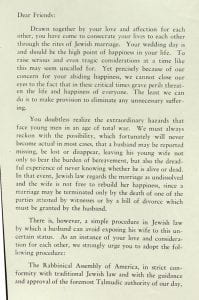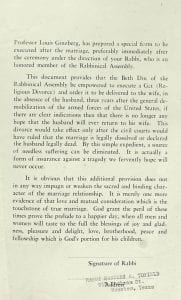by Katherine Webber
After the attack on Pearl Harbor in December 1941, Americans prepared themselves for war. War-time production began, dedicated American families bought war bonds and planted victory gardens, and young soon-to-be soldiers got married en masse. Women followed their new husbands to military bases, including Ellington Field outside of Houston, and Jewish servicemen and their families were bused to Houston for high holiday services.
Once done with training, Jewish service members were shipped out to all fronts of the war, and United Orthodox Synagogues’ collection in the Houston Jewish History Archive contains correspondence from the rabbi to both men and women serving in Europe, North Africa, and the Pacific. By the end of the war over 550,000 Jewish people had served, and 38,338 died during their service. Pamela S. Nadell, in her book America’s Jewish Women, describes a heart-wrenching account of a woman named Pearl learning of her husband’s death: “One morning Pearl woke up crying hysterically. Something had happened to Jules. Not long afterward a telegram confirmed that his bomber had gone missing in action on November 11, 1944. The war bride had become a war widow” (208). However, while Nadell proclaims that Pearl had become a widow, the case may in fact have not been so clear.
 The halakhah (Jewish law) which guides whether a woman has become a widow delineates that a woman’s husband must be proven dead, not assumed dead or simply missing. Without proof that her husband has died, a woman is not allowed to remarry and becomes an agunah, a woman who is tied to her missing husband who cannot grant her a divorce. Clearly, the issue of women who are both tied to and unsupported by their missing partners can be an issue at any time, but it becomes especially prevalent in times of economic distress, political upheaval, and war. For American women in the 1940s whose husbands went off to fight overseas, there was a very real possibility that their husbands could disappear and leave them not only with the grief of having lost a spouse but without the ability to ever have the financial support of a man in a world in which that support was necessary and assumed.
The halakhah (Jewish law) which guides whether a woman has become a widow delineates that a woman’s husband must be proven dead, not assumed dead or simply missing. Without proof that her husband has died, a woman is not allowed to remarry and becomes an agunah, a woman who is tied to her missing husband who cannot grant her a divorce. Clearly, the issue of women who are both tied to and unsupported by their missing partners can be an issue at any time, but it becomes especially prevalent in times of economic distress, political upheaval, and war. For American women in the 1940s whose husbands went off to fight overseas, there was a very real possibility that their husbands could disappear and leave them not only with the grief of having lost a spouse but without the ability to ever have the financial support of a man in a world in which that support was necessary and assumed.
With these circumstances in mind rabbis found a way to observe halakhah and curtail the problem of the agunah. Amongst the papers of Adath Yeshurun, an Orthodox synagogue which would later merge with Beth El to become Beth Yeshurun, I found a small flyer inconspicuously labeled, “A Personal Message on an Important Theme.” This pamphlet with a vague title was published by the Rabbinical Assembly, written for young couples who are about to be married. It explains briefly that if a man were to go missing at war or be presumed, but unconfirmed, to have died then his wife would be unable to “rebuild her happiness” through a new marriage. Because of this, the pamphlet urges the fiancé to work with his rabbi to preemptively sign a get, a bill of divorce, that the rabbi would then only issue to the wife after three years had passed since the end of the war, should her husband still be missing. Rabbi Tofield has stamped his name at the bottom of this pamphlet.
While it is unclear if Rabbi Tofield helped any Houstonian couple through this sort of prenuptial get agreement, it is clear that he and other American rabbis were aware of the issues that wartime could have for Jewish women and communities who hold to this halakha. For Pearl, a conditional get may not have relieved the grief of losing her husband at war, but it would have made her place in the Jewish world more clear, by untying her from her missing husband and allowing her the freedom to remarry.

